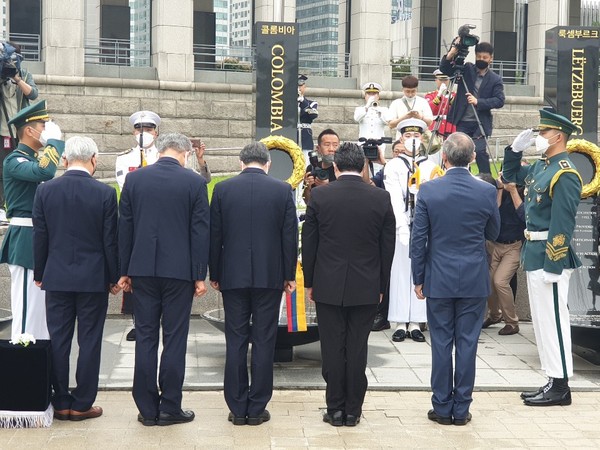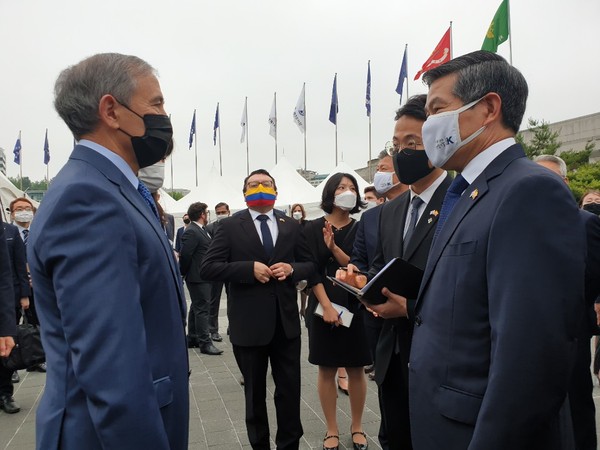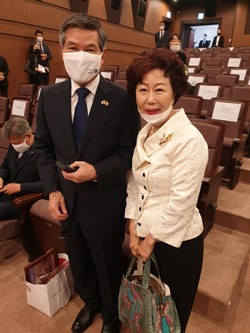Says Ambassador Caizar Rozero of Colombia at the Korean War Memorial Museum
By Feature Editor Ms. Joy Cho
Ambassador Juan Carlos Caizar Rozero of the Republic of Colombia in Seoul said that the participation of the Colombian soldiers in the Korean War in 1950-3 resulted in the modernization of the Colombian Armed Forces and also in the promotion of diplomatic relations and friendship with Korea.

Speaking at the memorial meeting of the Colombian soldiers, who gallantly fought for the freedom and democracy of Korea on June 26, 2020, Ambassador Caizar Rozero then added, “Thanks to the participation of the Colombian soldiers in the Korean War, Colombia and Korea have become allies and now partners in new technologies and in various other areas of bilateral cooperation.”
Ambassador Caizar Rozero hosted the memorial ceremony in honor of the Colombian soldiers fallen during the Korean War. It was attended by Minister of National Defense Jeong Kyeong-do of Korea and Ambassador Harry Harris of the United States and many other Korean and Colombian dignitaries.

Colombia is the only Central American country participating in the Korean War fighting on the side of the ROK and the U.N. Forces against the North Korean and Chinese Communist Forces who invaded the ROK starting on June 25, 1950. Colombia sent combat troops to Korea for the defense of the ROK, who numbered a total of 5,100, including one infantry battalion and Navy personnel. Of them, a total of 213 died in the defense of freedom and democracy of the ROK and there still are a number of fallen soldiers whose bodies have not yet been recovered.
Among the dignitaries attending the ceremony and offering memorial wreathes, besides Defense Minister Jong and Ambassadors Carzar Rozero and Harris, were Minister of Health and Welfare Park Neung-hoo and Chairman Lee Sang-chul of the War Memorial of Korea.

Also attending the ceremony were Ambassadors Drumus Ersin Ercin of Turkey, Zenani N. Diamini of South Africa, Daui Enrique Matute Meja of Peru, Bruno Figueroa Fischer of Mexico, Bruno Figueroa Fischer of Guatemala and Raul Silveroof Paraguay.
Korean news media, especially the leading Korean-language daily, Chosun Ilbo, introduced the remarks of Ambassador Caizar Rozero of Colombia. He was quoted as saying to the following effect:
Colombia is located near the Equator and therefore does not have distinctly different four seasons that countries like Korea have and besides in Colombia Spanish was spoken instead of English. This offered some difficulties to the Colombian soldiers in Korea at the time.
There are some sad stories such as that which was related to the combat at the Baldy Hill. The Colombian battalion at the time lost 95 soldiers killed, 97 others wounded, and 30 more who went missing as a result of engagement with the Chinese Communist Forces soldiers who carried out a nigh raid on the Colombian battalion.

There were steep mountains at the front frontline at the time which, to the Colombian soldiers, were a source of comfort to some extent as they resembled the Colombian terrain where there were many high mountains such as the Andes.
Ambassador Caizar Rozero said the participation of the Colombian soldiers in the Korean War resulted in the modernization of the Colombian Armed Forces and also in the promotion of diplomatic relations with Korea. Reports indicate that Ambassador Caizar Rozero can now speak in the Korean language to the effect that “Colombia and Korea have become allies and now partners in new technologies.”
Interestingly, Sgt. Maj. Gilberto Diaz Velasco (ret.) of the Colombian Army hosted a photo exhibition where he displayed a total 152 photos he took while serving the Colombian troops during the Korean War.
He took part in the Korean War at the age of 17 as a member of the Colombian Battalion attached to the 24th U.S. Army Infantry Division, and fought gallantly under a Colombian military slogan, “We never retreat!” He took part in the Geumseong Operation (October 1951) and Hill 400 Combat in Geumhwa (June 1954). Sgt. Maj. Diaz took a total of over 400 pictures covering various things up at the sharp front and of them, he put on display a total 152 pictures at the Korean War Memorial Hall in Samgak-ji Seoul, which runs through the end of December this year beginning on June 26.
The 152 photos, which the then Sgt. Maj. Gilberto Diaz Velasco took, will be exhibited online on the War Memorial of Korea website for the next six months starting June 6.
One of Diaz's photos, unveiled to media prior to the exhibition launch, shows himself and a fellow soldier, both clad in full sets of winter combat outfits like thick jumpers and furry caps, on an unidentified field covered in snow--a scene that is impossible to see back in his homeland.
Dias said through an interpreter: "It was very tough and challenging for me to adapt to the weather after I arrived in Korea because we don't have winter in Colombia."
Diaz then showed the camera that he used to take those photos--a Kodak he had bought in Japan for five dollars, which he said, “Even today, it works perfectly fine."
Sgt. Maj. Diaz arrived in Incheon in June 1951 and served for 14 months.
He is also a survivor of the fierce Battle of Old Baldy that took place at the height of the fight in Yeoncheon, a border county north of Seoul.
Diaz, 86, said he still recalls the moment in the wake of an ambush during the battle when he found himself in a field of dead bodies and had to look through them to find his closest peer.
"I couldn't tell which body belonged to him. Then I remembered he had a mustache. Not many had one. So I started touching the faces until I was able to recognize him by the mustache," he said.
Colombia was the only Latin American country to dispatch troops to the three-year conflict. Around 6,000 soldiers fought in the war under the UN flag against the North Korean forces backed by the Soviet Union and China.
As was briefly mentioned afore, the war left 140 Colombians killed, 71 missings, and 609 wounded.
"I wanted to reflect the daily lives of soldiers. But I know how important these pictures are not only for me, in general, but for world history."
"The camera was my best friend in Korea," Diaz told a group of journalists earlier this week in a video call from his home in Bogota. "We were always together and even now it's a part of my life. It still works perfectly."
"It was the first time I had experienced four seasons in my life," Diaz recalled. "It was especially tough and challenging to endure the winter because we don't have those kinds of temperatures in Colombia."
Diaz would also experience the horrors of the brutal war up close, including a bloody engagement in March 1953 on Old Baldy, a strategically located hill on the front lines that was the site of numerous battles throughout the conflict.
Both sides suffered massive losses, including one of Diaz's closest friends.
"It wasn't easy to tell which body belonged to him," Diaz said. "But I remembered that he had a mustache, and not many people had mustaches at that time. So I started touching faces in the piles of bodies until I was able to find my friend."
"When I started taking pictures, it was just a hobby," Diaz said. "I had no idea that my pictures were going to be relevant in world history. But now I feel very proud and happy that I can be a part of the history of both Koreans and Colombians."

